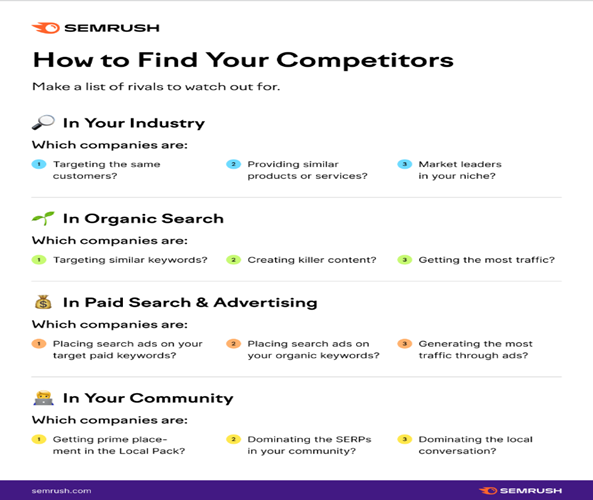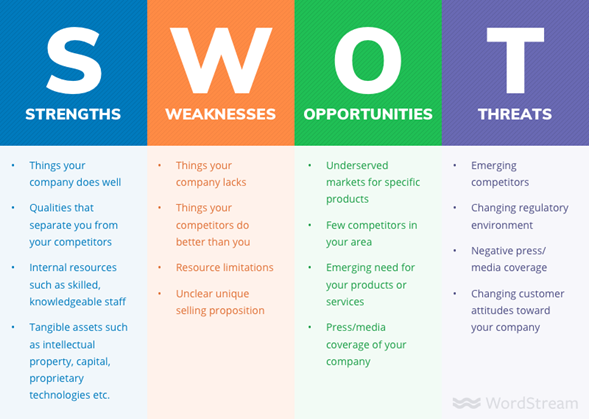How to Do Competitive Analysis and Gain Insights from Other Businesses to Improve Yours
in Business by Pohan Lin

Many of us wish our competitors would go away. It would be great to have all of the customers to ourselves! However, your competitors aren’t necessarily a negative for your business. In fact, they can give you some valuable insights.
Competitive analysis isn’t just about keeping tabs on your competitors. It’s also about improving your own business. By researching and analyzing what your competitors are up to, you can optimize your operation, generate leads, and gain a competitive advantage.
Here, we’ll teach you how to do a competitive analysis in ways that bring valuable insights to your own business.
1. Identify your competitors
Though it may seem obvious, you can’t analyze your competitors if you don’t know who they are!
There are various ways to find out your main competitors. A simple Google search is often effective. Type in your product or service, and see which companies pop up in the search results. You could even narrow it down by region if you need to.
Don’t forget to try out several keywords in order to search out all your competitors. For example, if your business is a hair salon in Brooklyn, you might search for ‘Hair salon Brooklyn’, ‘Hairdresser Brooklyn’, ‘Brooklyn hair and beauty’, ‘Barbers Brooklyn’ and so on.
Local business directories and your Chamber of Commerce are also great places to start for competitive analysis. Instance types of the right sort will help you sort and store the data if you find that you’ve got a lot of competitors to research!

Image sourced from SEMRush
Other ways to identify competitors include:
- Asking customers
- Searching social media
- Enquire within your network
- Attend industry events
2. Categorize direct and indirect competitors
There are two kinds of competition: direct and indirect. Direct competitors offer the same product/service as you. They may also aim for the same customer base as you and have comparable prices. Indirect competitors may have different products/services, audiences, and prices. However, while they’re not as much of a threat to you as direct competitors, their offering or experience may satisfy the same kind of need.
You have more to learn (and potentially more to lose!) from direct competitors, but you shouldn’t ignore indirect competitors. They can also yield some valuable insights.
3. Research your competitors’ products and content
Having identified your competitors, get to know their operations. Check out their product or service. Look for the ways in which they’re similar to yours and the ways in which they differ. What are their USPs, and how does your offering stack up in comparison?
Also, look at their content. How a company presents and markets itself and engages with customers is just as important (if not more important!) as its offering.
Gather as much data as you can on competitor content and engagement. You can speed this process up with things like autoML applications. Then, analyze what you’ve got.
What kind of content does each competitor produce? Blogs? Social media posts? Podcasts? Thought leadership pieces? What is their brand persona - are they positioning themselves as an authority? As an entertainer? As a maverick?
How can you position your own brand persona and content in relation to this? Is there an area where you know you can do better or a niche into which your content and marketing could expand?
What’s working for them, what isn’t, and what lessons can you draw from this?
The aim here isn’t to find out what your competitors are doing well and copy it. Differentiation is crucial for competitive advantage. However, you can use your competitors’ successes to learn more about the kinds of things that your customers like and enact those insights in your own unique way.
4. Research your competitors’ customer experience

Images sourced from Super Office
The way a customer experiences your brand is very important. If your competitors’ customer experience is better than yours, you will lose out.
What’s their customer service like? Do they respond to comments on their social media? How quickly do they get back to you if you message them?
Going ‘undercover’ is an excellent way to conduct this kind of research. By posing as a customer, you will learn about your competitors’ customer experience in the most direct way possible.
It’s often easy to tweak your customer experience in competitive ways. For example, perhaps your competitors get quotes out faster, meaning that customers don’t have to wait. In this case, simple quoting software could raise your game and give you an advantage.
5. Perform a SWOT analysis
A big part of competitor analysis is analyzing your own business. It’s only by understanding your own operation that you can compare it to others in insightful ways.
We suggest that you run a SWOT analysis. SWOT is good in this context because it’s framed easily in terms of competitor comparison.
SWOT stands for Strengths, Weaknesses, Opportunities, Threats.
For example, your strengths might include a superior product, great SEO, and a brilliant team. Weaknesses could include poor access to resources or a low market share. Opportunities could be things like access to emerging markets and events you could leverage to your advantage. Threats could include new regulations or strong competitors.
You might need to ingest a fair amount of data in order to run a positively accurate SWOT analysis. However, the data ingestion definition doesn’t have to include hours of staring at screens of numbers. Things like talking to your colleagues and customers definitely count as data-gathering!

Image sourced from Oberlo
6. Level up!
By this point, you should have a good idea of who your competitors are, how they operate, what they do well, what they do poorly, and how your own business matches up.
Now, it’s time to put what you’ve learned into action.
Using the results of your analyses, identify areas where you can make gains and improvements. For example, if your competitors are better than you at identifying and acting on customer pain points, plunge yourself into customer research and figure out how you can better respond to your customers’ needs in the moment.
If you come up with a long list of changes or improvements, try not to be daunted! It may be a lot of work, but it’s definitely worth it in order to give yourself a competitive advantage.
7. Test out your new competitive power
Nothing is ever perfect the first time. It takes trial and error to get things right. Whatever you’re changing or improving—be it your blog, your social media, your marketing, your internal ops, whatever—test it out.
As you would with a marketing campaign, pick a goal and tie it to a measurable metric. Your progress towards this goal will show you how successful your changes are. For example, if you are trying to gain a competitive advantage by improving your social media, you might set a target of obtaining 100 followers within a month.
If you don’t achieve that goal, you’ll know that what you’re doing isn’t working. Rather than continuing to beat this dead horse, you can then try out other tactics and methods.
When picking goals, we recommend making sure that they are SMART: Specific, Measurable, Attainable, Relevant, and Time-based.

Image sourced from Indeed
If you’re concerned about the impact of all this testing and trialing on your customers, consider automation. Putting your changes through a test automation or two could be very revealing. It will help you iron out any issues without having to use your customers as guinea pigs.
Use Competitive Analysis to Understand Your Market and Gain a Competitive Advantage
Hopefully, you now understand how to do a competitive analysis in a way that benefits your business. A good competitor analysis can be very revealing when done thoroughly and appropriately. It doesn’t just show you what your competitors are up to - it can give insights into what works for your customers, what doesn’t, what they like, what they need, and so on.
It can also reveal critical truths about your own business. By studying your competitors, you hold a mirror up to yourself. It can show you neglected areas of the market which you could move into and dominate. It can also show you areas of your own business which you may be neglecting or which could be profitably improved.
It can even tell you some home truths about your own reputation in the market.
All in all, competitor research isn’t just good for your business. It’s a necessity if you want to gain a competitive advantage.
We recommend that you do a competitive analysis once a year at the very, very least. Ideally, you would be keeping a close and constant eye on your competitors and conducting a complete competitor analysis whenever needed.
Through competitor research, you can learn a lot about your market, your customers, and your own business. So, what are you waiting for? Get Googling!




